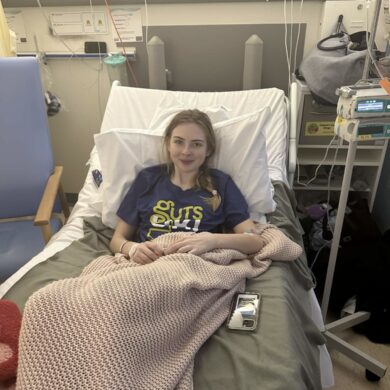Overview
This factsheet is about Eosinophilic Diseases
Eosinophilic Diseases (pronounced ee-oh-sin-oh-fil-ik) are often misdiagnosed because symptoms can mimic other more common diseases. Eosinophilic Diseases that affect the gut are identified by the presence of a type of inflammatory white blood cell called an eosinophil, which are raised above a normal level. When too many eosinophils congregate where they would not be usually present they can cause chronic inflammation, resulting in tissue damage.
Eosinophilic Diseases are diagnosed according to where the levels of eosinophils are elevated. In the gut they appear in two main categories: Eosinophilic Oesophagitis (EoE) and Eosinophilic Gastrointestinal Disorders (EGID). Current actual diagnosis figures are one in 3,000 for EoE in the UK and 1 in 100,000 for EGID in the USA.
Eosinophilic Diseases are often found in those with a family history of allergic diseases such as rhinitis, asthma and/or eczema. In fact a personal history of atopy (a predisposition to develop allergic diseases) is found prior to EOE diagnosis in 50-60% of cases. When the body wants to attack a substance, such as an allergy-triggering food or airborne allergen, eosinophils respond by moving into the area and releasing a variety of toxins.
Finding the appropriate medical care can be difficult as Eosinophilic Diseases are currently not widely recognised or understood.
Eosinophilic Oesophagitis
Sometimes described as Oesophageal Asthma, Eosinophilic Oesophagitis (EoE) is the more common of the eosinophilic gut disorders.
What are the symptoms?
The symptoms of EoE can vary from one person to another, and depend on age, but they are usually related to difficulty in getting food down the oesophagus (the tube going from mouth to stomach). The medical word for this type of swallow difficulty is dysphagia. However there are many types of dysphagia and the one that occurs in EoE is a feeling of food travelling more slowly down or (usually) sticking in the chest, often intermittently but sometimes with every swallow. The sensation of food sticking can range from mild, making eating difficult or uncomfortable, to severe and very distressing. It can occur without pain or with significant pain.
In children there can be difficulties with nutrition and poor growth, vomiting/regurgitation (sick going up and down, which can disturb sleep), food refusal (fussy eating), and abdominal and/or chest pain. In older children, adolescents and adults occasionally the food can stick severely stopping all other swallowed material for hours. This is called a food bolus obstruction and may require emergency medical attention.
Those suffering with long term undiagnosed EoE will often have learnt coping strategies such as:
- Excessive chewing and slow eating, being last to finish a meal.
- Food avoidance, such as meat and bread, preferring softer and/or wetter foods.
- Drinking a lot during a meal.
Symptoms of EoE can become so severe that it may prevent sufferers from normal social eating and cause anxiety particularly when eating out in a restaurant.
What is the cause of EoE?
The cause of EOE is not yet completely understood. It can be triggered by eating certain foods, most commonly (but not exclusively), milk, wheat, nuts, soya, fish and eggs. It is also possibly triggered by breathing in certain substances.
How do you get diagnosed?
A referral to an EoE expert Oesophageal Gastroenterologist is needed as the only way to make the diagnosis is by an examination with an endoscope (a flexible tube with a camera at one end) and to have biopsies taken (small tissue samples from the wall of the oesophagus).
The normal oesophagus has very few or no eosinophils present in biopsy samples but patients with EoE have a clear abnormality when levels are high, as defined by a density of eosinophils higher than 15/HPF (high power microscope field).
Neither blood tests nor x-rays are useful in the diagnosis of EoE.
What are the treatment options?
EoE is a chronic disorder that can wax and wane. Currently there is no known cure. There are various symptom management options, which need to be discussed with your expert consultant in EOE as each option has its pro and cons with a variable chance of success and may require one or more approaches, for example a combination of drugs and diet.
Dietary treatment
Sometimes the first dietary approach adopted by patients is often to avoid the types of food that stick. These may not actually be the foods that cause the inflammation but may just be solid types of food (meat or bread) that just get stuck and as such, eliminating them may be of little help in treating their condition.
Elimination diets of foods that might trigger the symptoms or inflammation
Although this is a natural method, it requires careful avoidance of 2 to 6, sometimes more, foods and repeated endoscopies (up to 7 or more) to discover the true reactivity to each food, so that a long-term plan can be reached. The common foods linked to the condition that might be excluded from the diet include milk, wheat, eggs, soya, rice, some fish and some vegetables (legumes). During this process careful attention to nutrition with the help of a dietitian expert in EoE is essential, as these diets can have a high success rate but they can be difficult to adhere to.
Elemental formula diet
There is a limited use for elemental formula diet in EoE and only after failure of properly performed medical treatment and/or elimination diet. This is mainly due to the fact that it can be difficult to drink due to its lack of palatability. As such, it can require a naso-gastric tube (a tube inserted from nose to stomach) in order to consume the correct amount needed for nutrition. Additionally, the negative impact on quality of life, such as the social and mental impact on the sufferer and their family when abstaining from all kind of normal eating, must be considered.
Topical steroids (budesonide or fluticasone)
These are the most effective medications and the only one licenced to treat EoE. Topical steroids have the ability to reduce the symptoms quickly in the majority of patients (up to 85% resolution of signs and symptoms 12 weeks after commencing therapy). They treat the underlying inflammation and so may prevent or treat the fibrous narrowing (strictures) that occur in some patients with EoE.
The treatment is given last thing before bed via either an asthma style pump which you swallow rather than inhale or slurry (a thick liquid) which you swallow to coat the affected area. For adults there is also a tablet that you dissolve on the tongue.
Proton pump inhibitors (Omeprazole Lansoprazole)
These drugs are often used for acid-related diseases (of which EoE is not one) and they reduce the symptoms and signs of inflammation in up to 50% of patients, when checked by biopsy. However, the degree of improvement has not been compared to other approaches, and no placebo controlled trials have been performed with Proton pump inhibitors (PPI).
Dilatation
This is an endoscopic procedure usually performed under sedation, in which a narrowing (stricture) is stretched to widen the calibre (diameter) of the oesophagus and allow food to pass through more comfortably. This therapy needs to be complemented with either dietary treatment or drugs, as described above.
Current EoE medical guidelines
Medical guidelines for the treatment of Eosinophilic Oesophagitis are available:
Eosinophilic esophagitis: Updated consensus recommendations for children and adults
Read more about the first licensed drug for Eosinophilic Esophagitis (EoE) hereEosinophilic Gastrointestinal Disorders
EGID cases are rare and can appear in both children and adults. They typically present with a combination of chronic nonspecific gastrointestinal symptoms, which include abdominal pain, diarrhoea and/or blood or mucus in the stool, constipation, nausea, vomiting/regurgitation (sick going up and down inside), weight loss or failure to thrive, and fatigue. Many have symptoms for several years and a diagnosis is often difficult and delayed.
The pattern of the EGID depends on which part of the gut is affected by the eosinophil inflammation:
- Stomach: Eosinophilic gastritis (EG).
- Small intestine: Eosinophilic Enteritis.
- Large intestine: Eosinophilic colitis (EC).
How is it diagnosed?
Unfortunately, unlike in the healthy oesophagus which has very few eosinophils, the lower part of gut contains some eosinophils even in a healthy person. This makes a diagnosis difficult in the UK at present, because research studies in this area have not yet agreed on a figure for raised levels of eosinophils, to be used in a diagnosis of the EGIDs. In various centres in the USA they have agreed thresholds that vary depending on the position within the gut.
Currently the diagnosis of these conditions relies on an expert Gastroenterologist performing a colonoscopy and an endoscopy and taking multiple biopsies which in turn show dense concentrations of eosinophils in the lining of the gut. This is done alongside a full assessment of the symptoms: the symptoms are not sufficient to provide a diagnosis but the observation that the symptoms are aggravated by specific foods can provide clues to the condition, as food intolerance seems to play a role in the cause of EGID. The diagnosis also requires careful exclusion of parasite infections and other types of inflammation in the gut.
What are the treatment options?
Identifying the causative foods in EGID can be extremely difficult and often there are multiple causes. Therefore, therapy is often a combination of multiple food type avoidance along with antihistamines, H2 blockers (ranitidine) and/or anti-inflammatory medication. When the condition only affects the colon a topical steroid (budesonide) may be used by enema, while if the small bowel is affected, delayed release tablets of budesonide may be useful.
In some complex patients these approaches are insufficient to control the EGID and there can be a serious degree of ill health. In these patients therapy with strong drugs such as systemic steroids (prednisolone) and other anti-inflammatory drugs maybe used. These can have significant side effects and a careful balance of the risks and benefits must be made by an expert in these diseases.
Currently there is no consensus on the best approach and no licenced therapies.
Achieving a healthy diet in those suffering with EGIDs can be challenging and expert medical help is essential.
Long term issues
Both forms of eosinophil gut disorder are long term conditions (chronic is the medical term) and therefore patients need a lifelong method to control the symptoms and reduce the potential complications. The lack of generally accepted therapies makes the management of the condition challenging for both doctors and their patients.
Support
The organisation EOS NETWORK supports people affected by these disorders. Visit their website here.
Research
More research is needed about EGID’s in order to develop medical guidelines for diagnosis and treatment.
LINKS:
 ABOUT US:
ABOUT US:
Guts UK’s vision is of a world where digestive diseases are better understood, better treated and where everyone who lives with one gets the support they need. We fund life-saving research into diseases of the gut, liver and pancreas.
Champion our cause; help us fight digestive diseases and change the lives of millions of people in the UK by supporting our work today.



